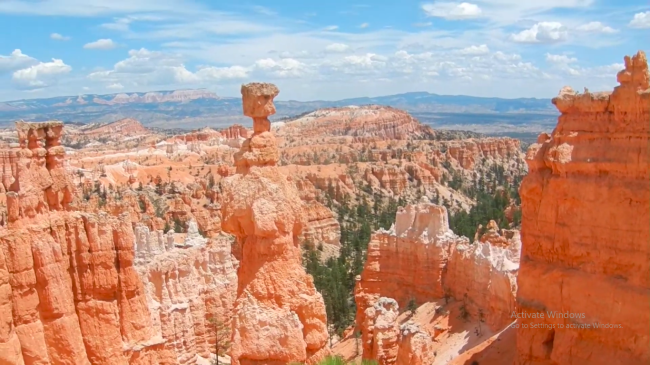Bryce Canyon Thor’s Hammer: A Majestic Marvel of Nature

Bryce Canyon National Park is home to one of the most awe-inspiring natural formations in the world—Thor’s Hammer. Standing tall amidst the vibrant red rocks of the canyon, this iconic rock formation, named after the legendary hammer wielded by the Norse god Thor, has captivated visitors for decades. This hoodoo, a testament to the power of erosion, symbolizes the unique geological beauty that defines Bryce Canyon.
What is Thor’s Hammer in Bryce Canyon?
Thor’s Hammer is a hoodoo, a term used to describe tall, thin spires of rock that protrude from the bottom of arid basins and badlands. Hoodoos are formed through a combination of frost wedging and rain erosion, which shape the landscape over millions of years. Thor’s Hammer stands out among these formations due to its distinctive hammer-like shape, where a giant rock sits balanced atop a narrow column of softer stone. This formation is easily recognizable and is one of the park’s most photographed features.
The Geological Formation of Thor’s Hammer
The creation of Thor’s Hammer is a process that spans millions of years. Bryce Canyon’s rock layers were originally laid down by ancient lakes and rivers, creating a sequence of limestone, siltstone, and sandstone. Over time, the natural elements began to wear away the softer layers, leaving behind the harder rocks that form the hoodoo’s “hammer” shape.
Water plays a significant role in hoodoo formation, mainly through frost wedging. During the cold months, water seeps into the cracks of the rock. When temperatures drop, the water freezes and expands, gradually breaking apart the softer layers of rock. This process repeats over thousands of years, eventually creating the towering spires we see today. Thor’s Hammer is a striking example of how nature’s forces sculpt the earth.
How to See Thor’s Hammer
Thor’s Hammer is located in the Bryce Amphitheater, the most visited section of Bryce Canyon National Park. The best vantage points for viewing Thor’s Hammer are Sunset Point and Sunrise Point, both accessible via the Rim Trail. Visitors can glimpse this impressive formation from these viewpoints or hike closer for an even more immersive experience.
Navajo Loop Trail
The Navajo Loop Trail is the perfect option for those who wish to get up close and personal with Thor’s Hammer. This popular 1.5-mile round-trip hike offers breathtaking views of the hoodoo from various angles. The trail is relatively easy but does have some steep sections, particularly when descending into the canyon. During the winter, parts of the trail may be closed due to icy conditions, so it’s best to visit during the warmer months if you want to hike the entire loop.
Sunrise and Sunset Views
One of the best times to visit Thor’s Hammer is sunrise or sunset. During these times, the changing light casts a magical glow over the canyon, highlighting the rocks’ vibrant red, orange, and pink hues. Photographers worldwide flock to Bryce Canyon to capture these stunning moments. The play of light and shadow on the hoodoos creates an almost surreal landscape, making sunrise and sunset the perfect times to experience Thor’s Hammer.
The Best Time to Visit Thor’s Hammer
Bryce Canyon National Park is open year-round, but the best time to visit Thor’s Hammer is in the fall. The weather during this time is mild, the summer crowds have subsided, and the trails are still accessible. Fall also offers some of the most dramatic lighting for photography, with the low-angle sunlight accentuating the colours and textures of the hoodoos.
Summer is another popular time to visit, though temperatures can rise significantly, and the park is more crowded. During the winter, Bryce Canyon is often blanketed in snow, creating a beautiful contrast against the red rocks, but the cold weather and icy trails can make hiking more challenging.
Practical Tips for Visiting Thor’s Hammer
- Wear Proper Footwear: The trails around Thor’s Hammer can be steep and slippery, especially after rain or during the winter months. Make sure to wear sturdy hiking boots with good traction.
- Bring Plenty of Water: Bryce Canyon is located at a high elevation, and the desert air can quickly lead to dehydration. Be sure to carry enough water, especially if you plan to hike the Navajo Loop Trail.
- Plan for Crowds: Thor’s Hammer is one of the most popular spots in Bryce Canyon, so try to arrive early in the morning or later in the evening to avoid crowds.
- Pack a Camera: The views of Thor’s Hammer are genuinely spectacular, particularly at sunrise and sunset. Whether you’re a professional photographer or just snapping photos on your phone, you’ll want to capture the beauty of this unique formation.
- Check Trail Conditions: If you plan to hike to Thor’s Hammer, check the trail conditions, especially in winter. Some sections of the trail may be closed due to ice or snow.
Thor’s Hammer and the Cultural Significance of Hoodoos
Hoodoos like Thor’s Hammer have long held cultural significance for the Native American tribes once inhabited the Bryce Canyon area. The Paiute people, who lived in the region for thousands of years, believed that the hoodoos were the petrified remains of ancient beings who had been turned to stone as punishment for their misdeeds. According to Paiute legend, the gods transformed these beings into the towering rock formations we see today.
Thor’s Hammer: A Photogenic Wonder
Thor’s Hammer is one of the most photogenic features in Bryce Canyon. The hoodoo’s contrasting colours, sharp angles, and unique shape make it a favourite subject for photographers. Capturing the beauty of Thor’s Hammer can be challenging, especially as the light changes throughout the day. However, with patience and the right timing, visitors can capture stunning photos that showcase the true beauty of this natural wonder.
Beyond Thor’s Hammer: Other Must-See Spots in Bryce Canyon
While Thor’s Hammer is one of the most iconic landmarks in Bryce Canyon, the park is home to many other breathtaking sights. Visitors can explore the Bryce Amphitheater, where thousands of hoodoos stand in a natural amphitheatre formation. The Queen’s Garden Trail and Fairyland Canyon are popular hiking destinations offering incredible views of the park’s unique rock formations.
For those who want to take in even more of the park’s beauty, the Rim Trail offers stunning panoramic views of the entire Bryce Amphitheater. This easy, accessible trail is perfect for visitors of all ages and abilities, allowing everyone to enjoy the awe-inspiring scenery.
Conclusion: Thor’s Hammer, A Natural Marvel
Thor’s Hammer is not just a rock formation—it’s a testament to nature’s power and the American Southwest’s beauty. Its distinctive shape, formed over millions of years by erosion, draws visitors worldwide who marvel at its grandeur. Whether you’re an avid hiker, a photographer, or a nature lover, Thor’s Hammer is a must-see destination in Bryce Canyon National Park.
When planning your trip, remember to bring plenty of water, wear proper footwear, and be prepared for the changing weather conditions. Whether you visit at sunrise, sunset, or any time, Thor’s Hammer will leave you in awe of its natural beauty.
By visiting Thor’s Hammer and the other incredible sights in Bryce Canyon, you’ll gain a deeper appreciation for the forces that shape our planet and the stunning landscapes that emerge.
Let the magic of Thor’s Hammer inspire your next adventure into the wonders of the natural world.


